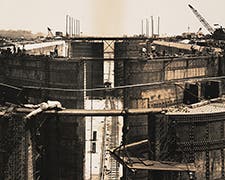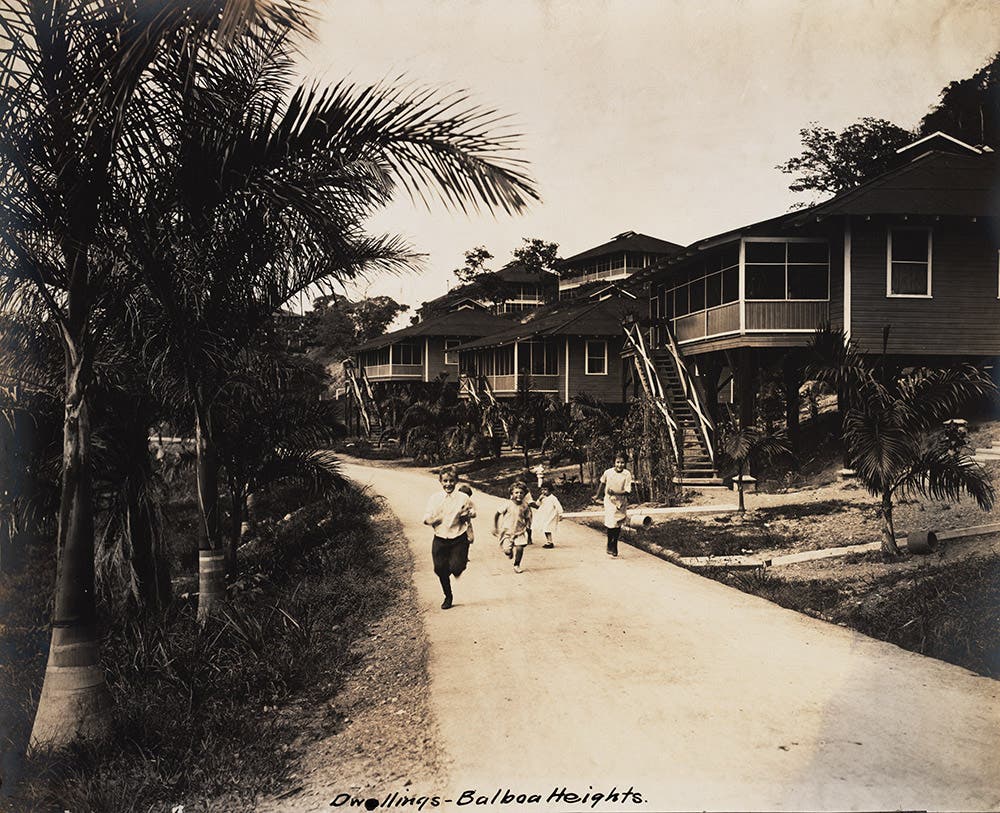
The Land Divided, The World United
Life in the Zone
“Nearly every steamer brought white men, wanderers over the face of the globe. [Men]came from S. Africa, from Australia, from Alaska, from the Philippines, from China, and especially from the Spanish American republics.” -A.B. Nichols

Modest housing at Balboa for gold payroll workers. Image source: Nichols, Aurin Bugbee, and Tirzah Lamson Nichols. Panama Canal Collection, 1846-1923 (bulk 1906-1914). Photograph Album 3, p. [101].
Gold payroll employees were encouraged to bring along wives and children, who were seen as a civilizing influence.
From 1904 to 1915, the Americans hired a workforce of 42,000 to build the Canal. At the beginning of construction, hiring workers at all levels was a difficult task. The Isthmian Canal Commission recruiters sought to fill the skilled jobs in America, offering good monthly salaries and free transport to the Isthmus, but many of the original recruits were unable to do the jobs for which they had been hired. Also, frightened by yellow fever and unable to face the harsh environment, half of the Americans fled the Canal during the first year of construction.
Although workers arrived from around the world, the Caribbean islands, primarily Barbados, supplied the bulk of the labor force. It was first believed that the islanders were unproductive by nature, but times were tough in their home countries and many were simply malnourished. Once fed a more varied and nutritious diet and given sufficient training, they performed well. However, the preparation of the food was, by most accounts, awful.
Silver payroll workers faced segregation, unequal treatment, and performed the most dangerous work. In contrast, gold payroll workers were given good housing, decent food, commissary privileges, and were supplied with recreational facilities.
Workers were paid under the “gold” and “silver” payroll system. The system was originally intended to designate skilled and unskilled labor but quickly grew into a system of segregation. Gold payroll workers were white, primarily American, more highly paid, and paid in U.S. gold coin. The silver payroll workers, mainly from the Caribbean islands but also from Spain, Italy and other European countries, were paid much less and in Panamanian silver coin. The system was a color line, with separate privileges, eating facilities, and building entrances for gold and silver workers.
Housing was provided free to gold payroll workers. In 1905, Chief Engineer Stevens appointed Jackson Smith to oversee labor and housing allocation. Jackson’s system allotted one square foot of housing for each dollar earned per month by a gold roll employee. If a man was married, his housing allotment doubled. American bachelors without families were assigned to private rooms in two-story dormitories. In contrast, bachelors on the silver roll were housed in shacks, barracks, or even rail cars.
To keep the gold payroll workers happy and to boost morale social activities were highly encouraged. The Y.M.C.A. club house at Culebra was typical, offering a bowling alley, billiard room, gymnasium, library, and bandstand. The cost of membership was $10 per year. Masons, Knights of Columbus, and a variety of social clubs were active in the Zone. Wives of gold roll workers usually had servants to help with the home and were urged to engage in social activities. Each town had women’s clubs, art and literary societies, and music and drama clubs. In 1907, the Cristobal Woman’s Club resolved “that every club woman in the Canal Zone constitute herself a committee of one to foster favorable instead of adverse criticism of the conditions of the Zone.”
